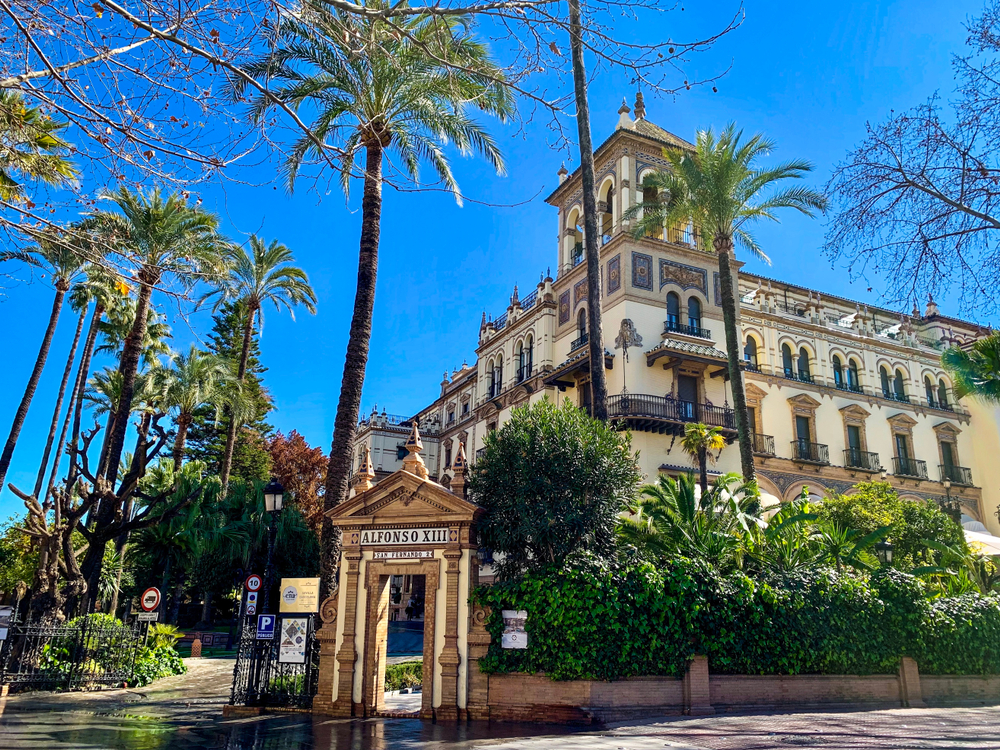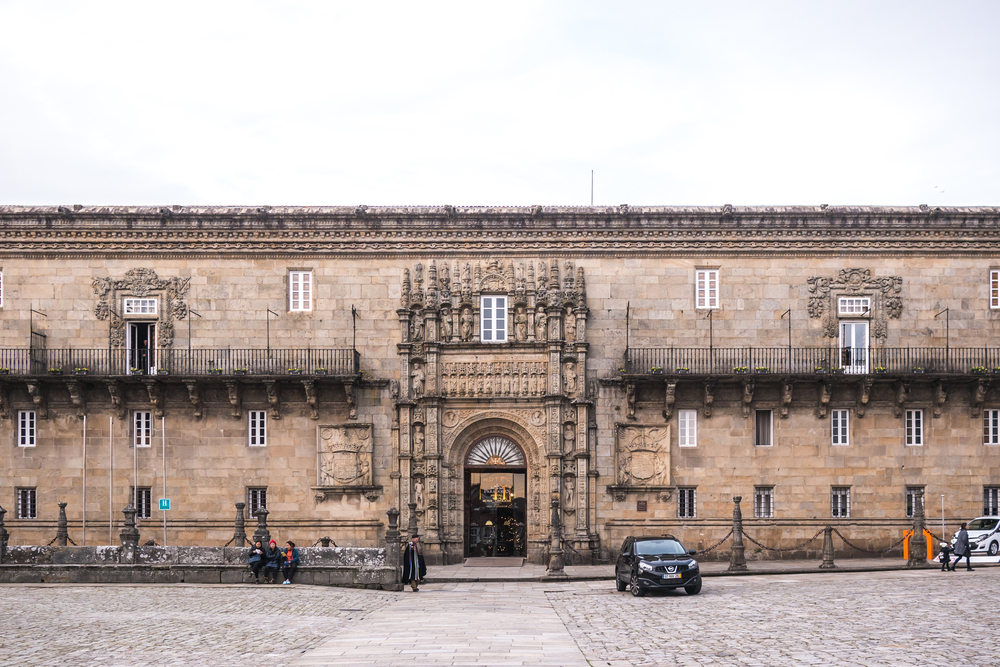Spain is home to some of the oldest and most charming hotels in the world, each with a story that blends history, culture, and timeless elegance. These historic establishments have hosted royalty, pilgrims, and travelers from across the globe, offering a unique glimpse into the country’s rich heritage. From grand palaces turned luxury retreats to serene monasteries repurposed as havens of hospitality, these are more than just places to stay—they are living pieces of history. Whether located in bustling cities or quiet countryside settings, they continue to preserve their architectural splendor and cultural significance. Here is a closer look at Spain’s oldest hotels, each with its own fascinating legacy and unique charm.
Hotel Alfonso XIII

Commissioned by King Alfonso XIII, this iconic hotel in Seville opened its doors in 1929 to accommodate guests of the Ibero-American Exposition. Designed by architect José Espiau y Muñoz, it exemplifies Neo-Mudéjar architecture, characterized by intricate tilework, arches, and lush gardens. It boasts 151 rooms and suites, each uniquely decorated to reflect Andalusian heritage. Over the decades, it has hosted numerous dignitaries, celebrities, and royalty, cementing its status as a symbol of luxury. A comprehensive renovation in 2012 ensured the preservation of its historical features while updating facilities to modern standards. Guests can enjoy amenities such as a swimming pool, fine dining restaurants, and proximity to its major attractions. Its opulent design and cultural significance continue to make it a must-visit destination in Andalusia.
Hotel Ritz Madrid

The Hotel Ritz Madrid, now known as the Mandarin Oriental Ritz, opened in 1910 and remains one of Spain’s most luxurious and historic hotels. Situated in the Golden Triangle of Art, it is steps away from the Prado Museum, Reina Sofía, and Thyssen-Bornemisza. Designed by César Ritz himself, it features Belle Époque architecture and interiors that exude elegance and grandeur. With 153 rooms and suites, it has hosted royalty, world leaders, and celebrities over the decades. A recent multi-million euro renovation preserved its classic charm while adding state-of-the-art amenities. Guests can indulge in Michelin-starred dining and enjoy the serene gardens that make the hotel an oasis in the bustling city. Its reputation as a cultural and social hub continues to attract discerning travelers from around the globe.
Gran Hotel La Toja

Located on the tranquil island of A Toxa in Galicia, the Gran Hotel La Toja has been a symbol of relaxation and elegance since its establishment in 1907. Famous for its natural thermal waters and therapeutic treatments, it became a favored retreat for European aristocracy and celebrities. Its neoclassical design, complete with sweeping gardens and sea views, enhances its allure as a wellness destination. Its 199 rooms and suites are designed to offer ultimate comfort, blending classical decor with modern conveniences. Guests can enjoy its world-class spa, offering a range of treatments using the island’s mineral-rich waters. The surrounding island features a casino, golf course, and scenic walking trails, making it a complete luxury getaway. It remains an iconic landmark for those seeking relaxation and sophistication.
Hotel Londres y de Inglaterra

Hotel Londres y de Inglaterra, founded in 1865, is one of the most iconic hotels in San Sebastián. Located along La Concha Beach, it offers guests breathtaking views of the Bay of Biscay. It has been a favored destination for celebrities, aristocrats, and writers, cementing its reputation as a cultural and social landmark. With 167 rooms and suites, it combines timeless elegance with modern comforts, featuring classic decor and contemporary amenities. Its prime location places it within walking distance of San Sebastián’s old town and renowned Michelin-starred restaurants. Guests can enjoy a luxurious dining experience at the hotel’s restaurant, which specializes in Basque cuisine. It continues to charm visitors with its blend of history, beauty, and sophistication.
Hospes Palacio del Bailío

The Hospes Palacio del Bailío in Córdoba is a stunning example of a historic hotel that seamlessly blends Roman, Moorish, and Renaissance influences. Originally built in the 16th century as a nobleman’s palace, it now serves as a luxurious retreat in the heart of the city. It is renowned for its carefully preserved Roman ruins, visible beneath a glass floor in its dining area. With 53 elegant rooms and suites, it offers a mix of traditional Andalusian decor and modern amenities. The outdoor gardens and courtyard, complete with a pool and fragrant orange trees, provide a tranquil escape from the city’s hustle and bustle. Guests can also indulge in the hotel’s Bodyna Spa, which offers treatments inspired by ancient Roman baths. Located near Córdoba’s historic sites, including the Mezquita-Catedral, it is an ideal base for exploring the city’s rich heritage.
Parador de León

The Parador de León, also known as the Hostal de San Marcos, is a masterpiece of Spanish Renaissance architecture, located in the city of León. Originally built in the 16th century as a monastery and hospital for pilgrims traveling the Camino de Santiago, it later evolved into a luxury hotel. The building’s intricately carved façade, expansive cloisters, and grand interiors are testaments to its historical and artistic significance. In 1965, it became part of the Paradores network, offering 51 lavishly decorated rooms that reflect its storied past. It underwent a comprehensive renovation in 2020, preserving its historic charm while incorporating modern comforts. Guests can explore its museum-like interiors, which house collections of art, antiques, and medieval artifacts. Its prime location along the Camino makes it an iconic destination for travelers seeking history and luxury in León.
Parador de Úbeda

Housed in a 16th-century Renaissance palace, the Parador de Úbeda is located in the historic Plaza de Vázquez de Molina in Úbeda, Jaén. The building, originally constructed for the dean of the Málaga Cathedral, showcases classic Spanish Renaissance architecture with a symmetrical façade and a central courtyard. In 1930, it was converted into one of Spain’s first Paradores, offering guests a unique blend of historical ambiance and modern comfort. The hotel features 36 rooms, each adorned with period furnishings and views of the surrounding historic sites. Guests can dine in the hotel’s restaurant, which serves traditional Andalusian cuisine in a setting that reflects the building’s storied past. Its location provides easy access to Úbeda’s UNESCO World Heritage sites, including other Renaissance palaces and churches. Its serene courtyard and historical charm make it a standout in Spain’s luxury accommodations.
Parador de Granada

Located within the Alhambra complex, the Parador de Granada occupies a former 15th-century convent built atop a Nasrid palace. This unique hotel offers guests an unparalleled opportunity to stay within one of Spain’s most famous UNESCO World Heritage Sites. Its architecture blends Moorish, Renaissance, and Gothic elements, with interiors that reflect its long history. It features 40 rooms, many of which provide stunning views of the Alhambra gardens and the city of Granada. Guests can dine in the hotel’s restaurant, which serves Andalusian specialties inspired by Moorish culinary traditions. It offers an intimate and serene atmosphere, perfect for exploring the historic surroundings. Staying here allows visitors to fully immerse themselves in the beauty and history of the Alhambra.
Parador de Santiago de Compostela

Established in 1499, the Parador de Santiago de Compostela, also known as Hostal dos Reis Católicos, is situated in the historic Plaza del Obradoiro, adjacent to the renowned Santiago de Compostela Cathedral. Originally commissioned by the Catholic Monarchs, Ferdinand and Isabella, it served as a hospital and lodging for pilgrims completing the Way of St. James. The building showcases a Plateresque façade and encompasses four cloisters, elegant corridors, and a chapel, reflecting its rich history. In 1954, it was transformed into a luxury hotel and later integrated into the Paradores network in 1986. Today, it offers 137 rooms, blending historical charm with modern amenities. It continues its tradition of hospitality by providing free meals daily to a limited number of pilgrims. It remains one of the most emblematic hotels in Spain, connecting centuries of history with luxury.
Parador de Cardona

Perched on a hill overlooking the town of Cardona in Catalonia, the Parador de Cardona is a striking medieval castle-turned-hotel dating back to the 9th century. The castle, originally built as a fortress, features Romanesque and Gothic architecture, including a well-preserved tower and a church from the 11th century. Converted into a Parador in 1976, the hotel offers 54 rooms that maintain a medieval ambiance with stone walls, wooden beams, and antique furnishings. Guests can dine in the hotel’s restaurant, which serves Catalan cuisine in a setting that evokes the castle’s storied past. It offers sweeping views of the surrounding countryside, making it a favorite destination for history enthusiasts and nature lovers. Its proximity to the famous salt mines of Cardona adds another layer of interest for visitors. Staying here provides a unique opportunity to experience life in a medieval fortress with modern-day comforts.
This article originally appeared on Rarest.org.
More from Rarest.org
11 Highly Desired Antique Kitchenware Items Collectors Treasure

Collecting antique kitchenware offers a glimpse into history while adding charm to any kitchen or display. From durable cast iron skillets to delicate china patterns, these items have both functional and decorative value. Read More.
9 Most Expensive Vintage Porcelain Figurines Ever Collected

Porcelain figurines have long been treasured for their intricate craftsmanship and delicate beauty. Collectors are willing to pay extraordinary amounts for rare, vintage pieces that carry historical value and artistic elegance. Read More.
15 Lavish Cruise Lines Offering the Best in Comfort and Style

When it comes to luxury travel, few experiences can match the opulence and comfort of a cruise. For those seeking the ultimate in relaxation and style, selecting the right cruise line is essential. Read More.
